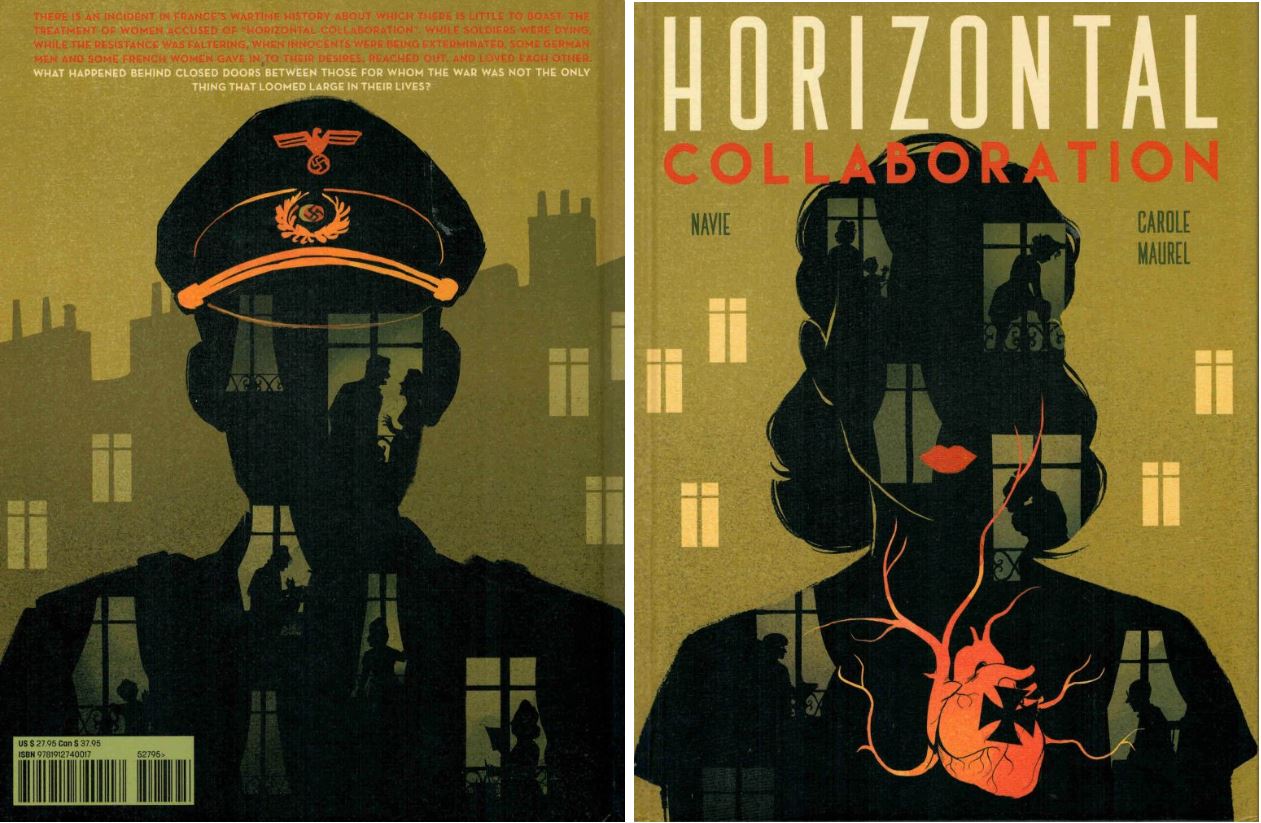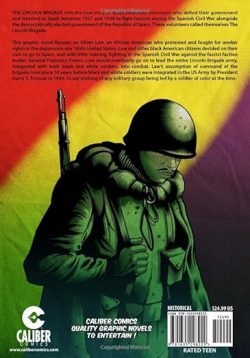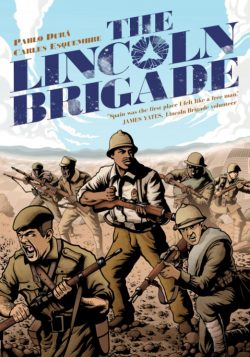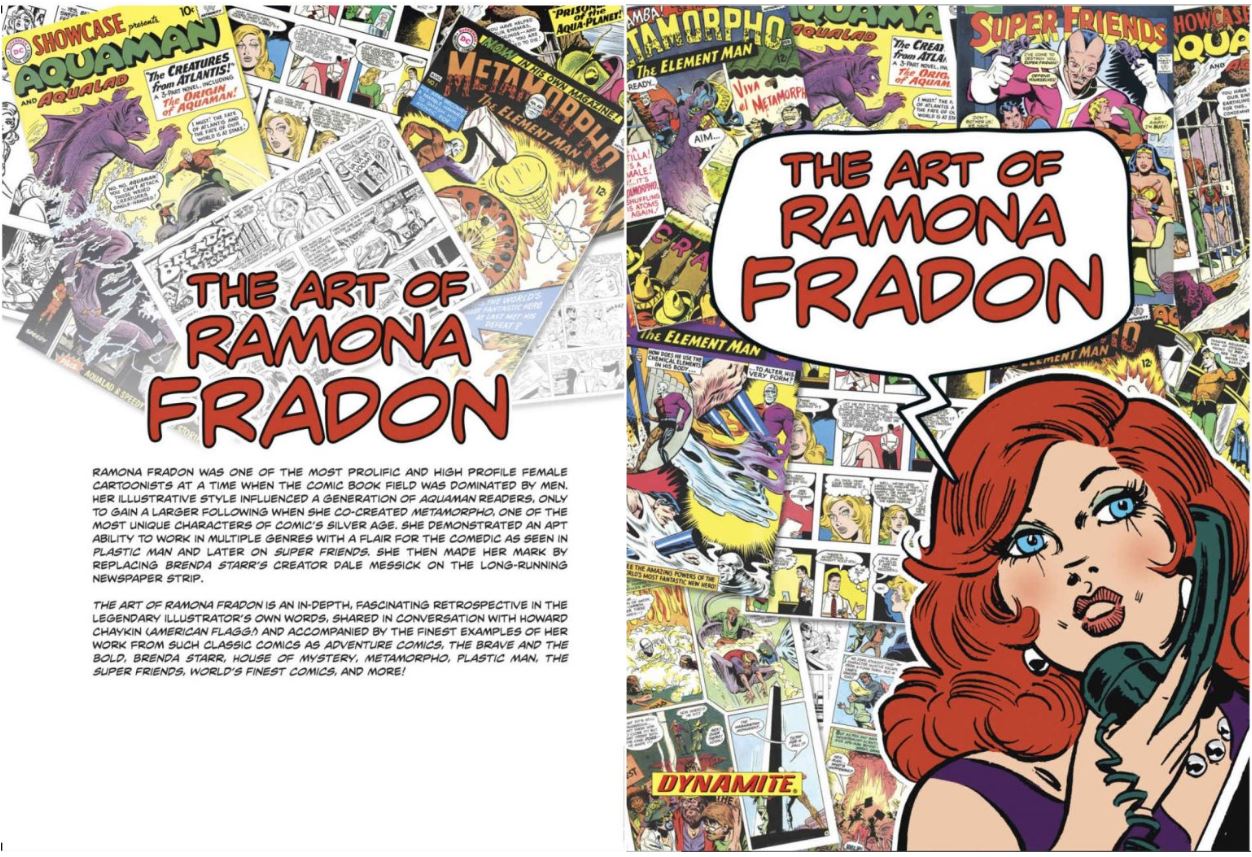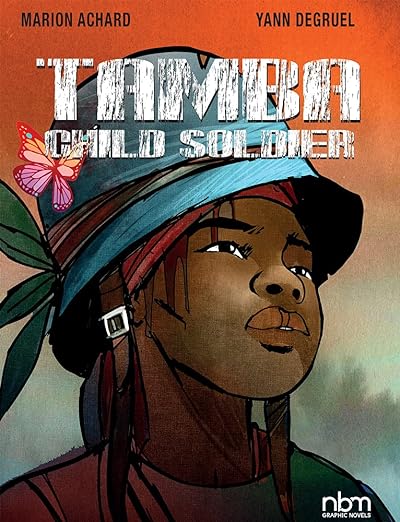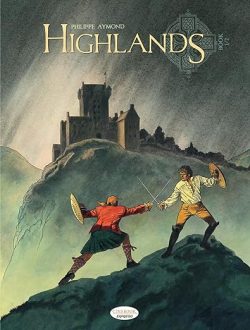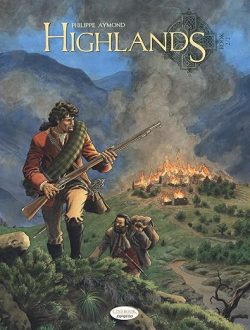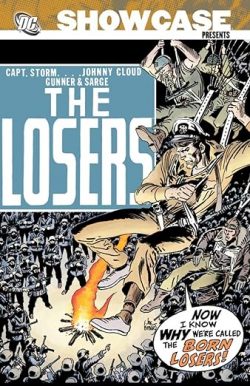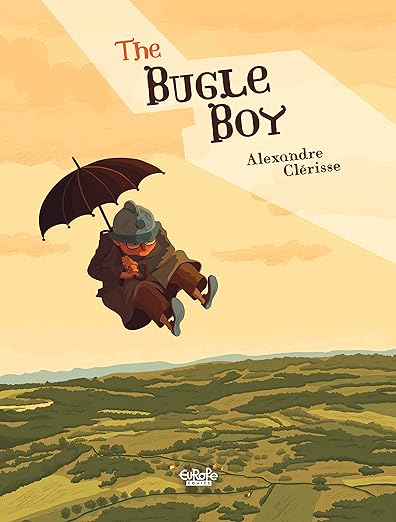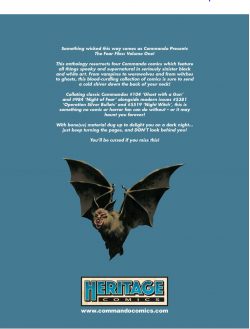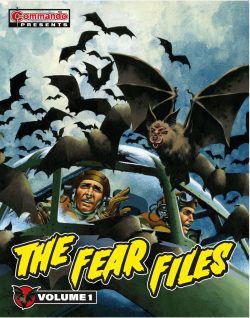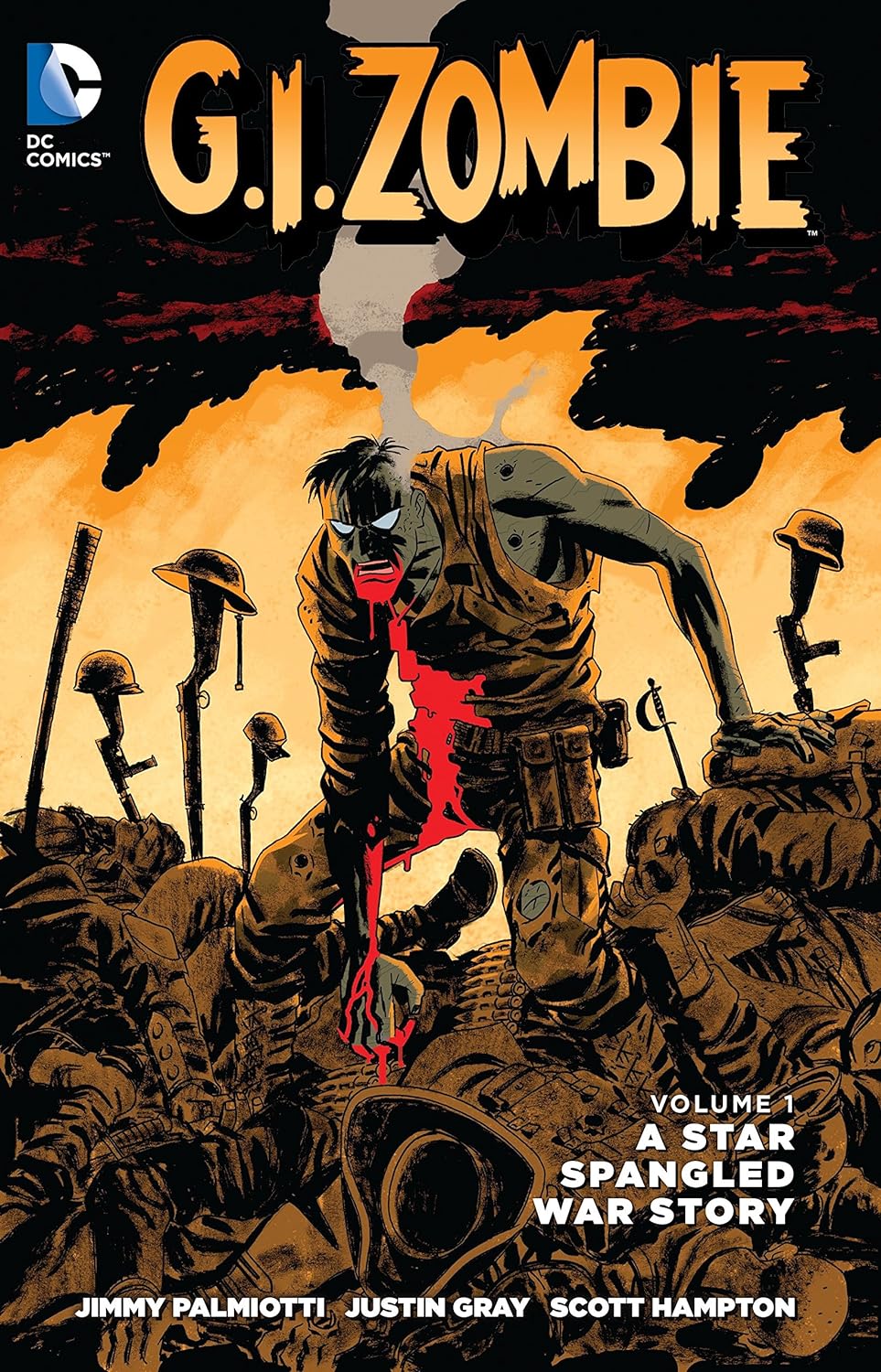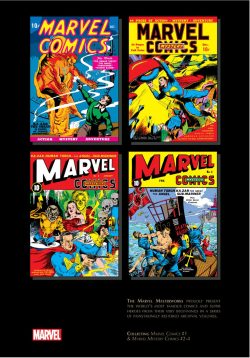
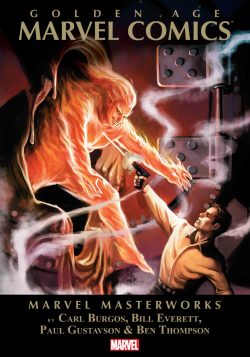
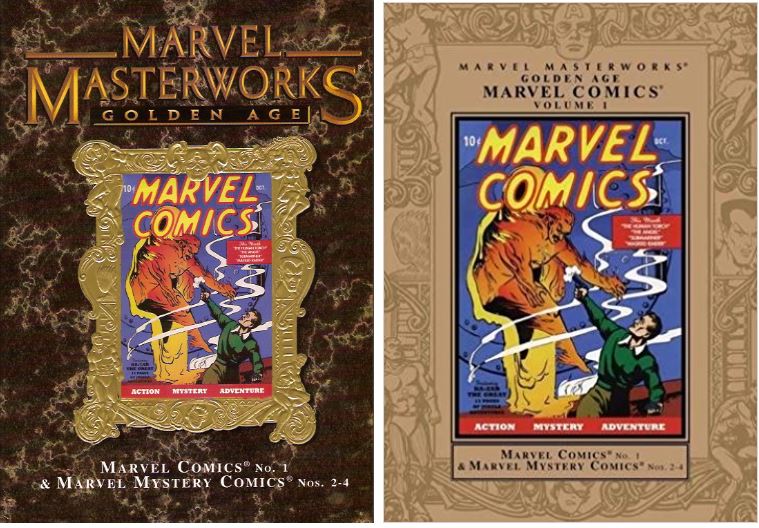
By Carl Burgos, Bill Everett, Paul Gustavson, Ben Thompson, Ed Wood/Fred Schwab, Al Anders, Tomm Dixon/Art Panajian, Steve Dahlman, Stockbridge Winslow/Bob Davis, Irwin Hasen, Ray Gill, David C. Cooke, Charles J. Mazoujian, Paul Lauretta, Harry Ramsey, Alex Schomburg & others (MARVEL)
ISBN: 978-0-7851-1609-7 (HB/Digital edition) 978-0-7851-5052-7 (TPB)
There are many comics and strip anniversaries this year and this title ranks among the most significant, containing not one but two superstar launches and a few minor milestones too…
After a rather shaky start and inauspicious in 1936, the fledgling comic book industry was saved by the invention of Superman two years later. His iconic innovations launched a new popular genre and paved the way for explosive expansion. By 1939 the new kids on the block were in a frantic flurry of creative frenzy with every publisher trying to make and own the Next Big Thing.
Martin Goodman’s pulp fiction outfit leapt into the turbulent marketplace and scored big with initial offering Marvel Comics, released late in the year before inexplicably switching to the marginally less euphonious Marvel Mystery Comics with the second issue. During those early days, novel ideas, raw ambition and sheer exuberance could take you far and, as most alternative means of entertainment escapism for kids were severely limited, it just wasn’t that hard to make a go of it as a comic book publisher. Combine that with a creative work-force which kept being drafted, and it’s clear to see why low and declining standards of story and art didn’t greatly affect month-to-month sales during the years of World War II.
However, once hostilities ceased a cascade-decline in superhero strips began even before GI boots hit US soil again. Those innocent kids had seen a lot and wanted something more than brashness, naivety and breakneck pace from their funnybooks now…
Both The Human Torch and Sub-Mariner quickly won favour with the burgeoning if fickle readership, but the remaining characters were soon acknowledged to be B-listers and subject to immediate replacement if a better idea presented itself. Still, 2 out of 7 was pretty good: Action and Detective Comics only had one super-star apiece at the outset. Another holdover from the pre-comics, pulp fiction era of the company was its tendency to treat instalments as serial chapters; always promising more & better if you’d just come back next month…
Before the year was out Timely’s “Big Two” would clash – frequently and repeatedly battling like elemental gods in the skies above Manhattan. Goodman apparently favoured Ka-Zar and The Angel: both characters devolving from his own stable of pulp genre stars. Sadly, neither generic jungle adventures of the company’s premiere Tarzan knockoff nor the thud-&-blunder crimebusting rogue’s potboilers – which owed so much to Leslie Charteris’ iconic dark knight The Saint – appeal to kids like the spectacular graphic histrionics of anarchic Fire and Water anti-heroes did…
An editorial policy of rapid expansion was quickly adopted: release a new book filled with whatever was dreamed up by the art-&-script monkeys of the comics “shop” (freelancers who packaged material on spec for publishing houses: Martin Goodman bought all his product from Lloyd Jacquet’s Funnies Inc.), keep the popular hits and ditch everything else. Timely Comics, or Red Circle as the company occasionally called itself, enjoyed a huge turnover of characters who only minimal appearances before vanishing, thereafter un-seen again until modern revivals or recreations produced fresh versions of characters like Angel, Ka-Zar or Electro.
This volume – available in hardback, softcover and eBook editions – kicks into high gear following a knowledgeable and informative scene-setting introduction by Golden Age Guru Roy Thomas. The landmark Marvel Comics #1 sported a cover by pulp illustrator Frank R. Paul, and after spot gag page ‘Now I’ll Tell One’ (by “Ed Wood” – AKA Fred Schwab) introduces to the gasping populace Carl Burgos’ landmark conception ‘The Human Torch’…
The Flaming Fury led off a parade of wonderment, bursting into life as a malfunctioning humanoid devised by Professor Phineas Horton. Igniting into an uncontrollable blazing fireball whenever exposed to air, the artificial innocent was condemned to entombment in concrete but escaped to accidentally imperil the city until falling into the hands of a gangster named Sardo. When his attempts to use the gullible android as a terror weapon backfire, the hapless newborn is left a misunderstood fugitive, like a modern-day Frankenstein’s monster. Even his creator only sees the flaming waif as a means of making money…
Crafted by Paul Gustavson (Human Bomb, Fantom of the Fair, Man O’ War), the opening episode of ‘The Angel’ owed a litigiously large debt to 1938 Louis Hayward film The Saint in New York. Although dressed like a superhero, the globetrotting do-gooder offered a blend of Charteris’s iconic valiant scoundrel and The Lone Wolf (Louis Vance’s urbane 2-fisted hero who was subject of 8 books and 24 B-movies between 1917 and 1949). However, the four-colour paladin’s foes soon tended towards only the spooky, the ghoulish and the just plain demented. He also seemed able to cast giant shadows in the shape of an angel. Not the greatest aid to cleaning up the scum of the Earth, but he coped in his initial enterprise when tasked with cleaning up New York’s gang problems and dealing with the deadly depredations of a crime syndicate dubbed ‘The Six Big Men’…
Bill Everett’s contribution ‘The Sub-Mariner’ was actually an expanded reprint of a beautiful black-&-white strip from Motion Picture Funnies. Prince Namor was scion of an aquatic civilisation living under the South Pole. These technologically advanced merfolk had been decimated by American mineral exploration a generation previously, and Namor’s future mother Fen had been dispatched to spy upon them. She had gotten too close, fallen pregnant by one of the interlopers. Twenty years later her amphibious mutant-hybrid son was bent onto exacting revenge on the air-breathers – which he began by attacking New York City…
Cowboy Jim Gardley was framed by ruthless cattle-baron Cal Brunder and found the only way to secure a measure of justice was to become ‘The Masked Raider’: dispensing six-gun law. Al Anders’ Lone Ranger riff was competent but uninspired, lasting until Marvel Mystery #12. Offering a complete adventure, ‘Jungle Terror’ by Tomm Dixon (aka Art Panajian) follows gentlemen explorers Ken Masters and Tim Roberts (pictorially patterned on Caniff’s Pat Ryan and Terry Lee) battling savages in the Amazon to find cursed diamonds. After a brief prose vignette – a staple of early comics – detailing Ray Gill’s racing car drama ‘Burning Rubber’ the aforementioned ‘Adventures of Ka-Zar the Great’ begins with Ben Thompson (The Masked Marvel, Hydro-Man) adroitly adapting Bob Byrd’s pulp novel King of Fang and Claw to strip serial form. In the first chapter, South African diamond miner John Rand and his wife crash their plane into the Belgian Congo where their son David grows up amidst jungle splendour to become brother to King of Lions Zar. An idyllic life is only marred years later when murderous explorer Paul De Kraft kills old John, leaving young David to seek vengeance…
Behind a Charles J. Mazoujian Angel cover, the abruptly re-titled Marvel Mystery Comics #2 (December 1939) again offered ‘The Human Torch’ by Burgos, wherein the fiery fugitive attains a degree of sophistication and control before stumbling onto a murderous racing car racket. Here gangster Blackie Ross ensures his drivers always win by strafing other contestants from an airplane, until the big-hearted, outraged Torch steps in…
Gustavson despatched ‘The Angel’ to Hong Kong to stop museum researcher Jane Framan falling victim to a curse when the perils of The Lost Temple of Alano prove to be caused by greedy men, not magical spirits, but ‘The Sub-Mariner’ himself is the threat in Everett’s second chapter, as the Marine Marvel goes berserk in a NYC powerhouse before showing his true colours by chivalrously saving a pretty girl caught in the ensuing conflagration. Anti-heroism gives way to traditional nobility as Anders’ ‘Masked Raider’ then breaks up an entire lost town of outlaws, after which the debuting ‘American Ace’ (by Paul Lauretta and clearly based on Roy Crane’s soldier of fortune Wash Tubbs) finds Yankee aviator Perry Wade flying straight into danger when the woman who caused the Great War returns to start WWII by attacking innocent European nations with her hidden armies…
‘The Angel’ stars in an implausible, jingoistic prose yarn (by David C. Cooke illustrated by Mazoujian), single-handedly downing a strafing ‘Death-Bird Squadron’ whilst Thompson introduced fresh horrors – including a marauding, malicious ape named Chaka – to plague young David in more ‘Adventures of Ka-Zar the Great’ before the issue ends with gag pages ‘All in Fun’ by Ed Wood and ‘Looney Laffs’ from Thompson.
Cover-dated January 1940 and sporting an Alex Schomburg Angel cover, Marvel Mystery Comics #3 saw ‘The Human Torch’ evolving into a recognisable superhero series as he battles a ruthless entrepreneur trying to secure the formula for a super-explosive he can sell to Martian invaders, whilst ‘The Angel’ confronts a bloodthirsty death-cult sacrificing young women. Next ‘The Sub-Mariner’ takes a huge leap in dramatic quality after policewoman Betty Dean entices, entraps and successfully reasons with the intractably belligerent subsea invader. With global war looming ever closer, opinions and themes constantly shifted and Everett reacted brilliantly by turning Namor into a protector of all civilians at sea: preying on any warlike nation sinking innocent shipping. Naturally, even before America officially joined the fray, that meant primarily Nazis got their subs and destroyers demolished at the antihero’s sinewy hands…
When gold and oil are discovered under ranch land, ‘The Masked Raider’ steps in to stop greedy killers driving off settlers in a timeless tale of western justice, whereas current events overtook the ‘American Ace’, who faded out after his tale of blitzkrieg bombings in a picturesque Ruritanian nation. Even Cooke & Everett’s text thriller ‘Siegfried Suicide’ was naming and shaming the Axis directly in a yarn of a lone Yank saving French soldiers from German atrocity, before neutrality resumes as, under African skies, the ‘Adventures of Ka-Zar the Great’ sees the boy hero rescue his animal friends from a well-meaning zoo hunter in a tale revealing hints of a Jungle Book style congress of animals…
The final inclusion – Marvel Mystery Comics #4, February 1940 – opens with a Schomburg cover depicting Sub-Mariner smashing a Nazi U-Boat before another inflammatory Burgos ‘Human Torch’ epic sees the android create secret identity Jim Hammond and return to New York to crush a criminal genius terrorising the city with warriors cloaked in lethal, sub-zero ‘Green Flame’…
‘The Angel’ too is in the Big Apple, hunting a small time hood manipulating a monstrous hyper-thyroid case named ‘Butch the Giant’. Impervious to pain and able to punch through brick walls, this slavish meal ticket is eventually overcome, after which ‘The Sub-Mariner Goes to War’ as the passionate Prince rallies his Polar people, employing their advanced technology in a taskforce enforcing his Pax Namor upon the surface world’s war mongers…
Even by its own low standards ‘The Masked Raider’ tale of claim-jumping is far from exemplary, but prose crime puzzler ‘Warning Enough’ (Cooke & Harry Ramsey) is a genuinely enthralling change of pace tale.
Rendered by Steve Dahlman, ‘Electro, the Marvel of the Age’ introduces brilliant Professor Philo Zog who constructs an all-purpose wonder robot and forms an international secret society of undercover operatives who seek out uncanny crimes and great injustices for the automaton to fix. The first case involves retrieving a kidnapped child actress…
Another debut is ‘Ferret, Mystery Detective’ by Stockbridge Winslow (Bob Davis) & Irwin Hasen, following the eponymous crime-writer and his faithful assistants as they solve the case of a corpse dropped on the authors doorstep. Proceedings culminate with another winner in the ‘Adventures of Ka-Zar the Great’ as despised villain De Kraft returns to face the beginning (but not the end: that’s frustratingly left to the next issue …and volume) of the jungle lord’s just vengeance…
Despite many problems – especially its regrettable populist tendencies and desperately dated depictions of race, class, ethnicity and gender – I’m constantly delighted with this substantial chronicle, warts and all, but I can fully understand why anyone other than a life-long comics or Marvel fan might baulk at the steep price-tag in these days of grim austerity, with a wealth of better quality and more highly regarded comics collections available. Nevertheless, value is one thing and worth another, and the sheer vibrantly ingenious rollercoaster rush and vitality of these tales, even more than historical merit or cultural obsolescence, is just so intoxicating that if you like this sort of thing you’ll love this sort of thing.
If anything could convince the undecided to take a look, later editions also include numerous tantalising house ads of the period and a full colour cover gallery of Marvel Mystery Comics’ pulp predecessors: Marvel Science Stories, Marvel Tales, Marvel Stories, Ka-Zar, The Angel Detective, Uncanny Tales, Mystery Tales, Dynamic Science Stories and Star Detective Magazine by illustrators Norman Saunders, Frank R. Paul, H. W. Wesso and John W. Scott. Upping the ante, further bonuses comprise the second print cover of Marvel Comics #1, a sample of Norman Saunders’ original painted art, Everett Sub-Mariner pages and unused cover roughs, a Mazoujian-pencilled Angel cover reworked into the never-printed Zephyr Comics ashcan cover and a Burgos watercolour sketch offering a partial redesign of The Human Torch.
Although probably not to the tastes of most modern fans, for devotees of superheroes, aficionados of historical works and true Marvel Zombies there’s still plenty to enjoy here, and as always, in the end, it’s up to you…
© 1939, 1940, 2004, 2017 Marvel Characters, Inc. All rights reserved.
